It looks like you're using an Ad Blocker.
Please white-list or disable AboveTopSecret.com in your ad-blocking tool.
Thank you.
Some features of ATS will be disabled while you continue to use an ad-blocker.
share:
Originally posted by Varemia
reply to post by JibbyJedi
Did you remember that the Madrid building was built after NIST gave its recommendations on how to stop a fire-caused collapse from happening? Or how the building was designed differently? Or how it still suffered local collapses?
Oh, wait. I forgot. You guys only know what's convenient to your theories. My bad.
How did NIST miss this damage?
Originally posted by webpirate
The planes did not hit either building exactly straight on. It wouldn't take much of an angle at all to cause certain areas to look like they were hit like these images show.
NIST seems to think it was pretty much, straight and mostly level.
If the wings could damage the wrong side of the columns on the left, why not on the right?
Originally posted by TMJ1972
from what i see on the pictures it looks like the damage in question was caused by the portside wingtip.
The image suggests that the columns not sheered off in this section.
I would like to disagree in the statement that the wing must have travelled from left to right to cause this damage.
From what i would expect if a wing hits those beams with such a speed is, that they start disintegrating and build up momentum in a way that sections of the wing start to wriggle around the columns into the gaps and exert force to the beams in the way depictured in the photo.
From what I understand, if the beams in question struck the much lighter weight wings at 500 MPH, the wings would be shredded by the columns.
This is what the NIST tried to explain:
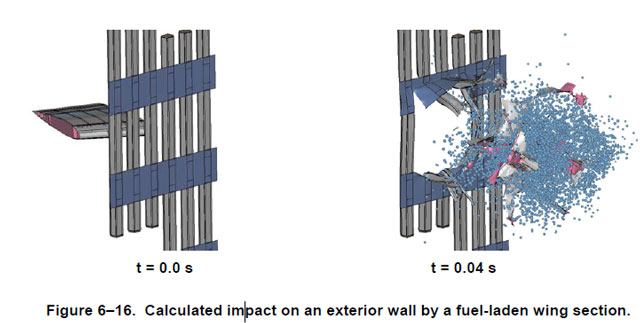
Whereas, this damage looks like a missile dented a few columns and exploded,
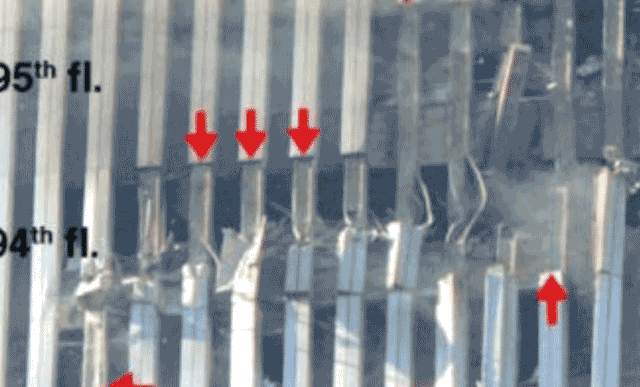
Originally posted by septic
From what I understand, if the beams in question struck the much lighter weight wings at 500 MPH, the wings would be shredded by the columns.
The wings had fuel in them they were much heaver.
If you look closely at the photo the columns are pushed in, they are no longer strait and flush with the face of the building. The columns merely buckled inwards at the point of impact. The compressed metal in the column flange had to go some where. Sideways was the path of least resistance in this case.

Do you see the woman standing on the edge to the left of of the picture in one of the NIST pictures?
There is a picture showing a close up of the impact zone where a bloke can be seen peering through the window with his hands cupped over his eyes, back the other way from the woman
There is a picture showing a close up of the impact zone where a bloke can be seen peering through the window with his hands cupped over his eyes, back the other way from the woman
Originally posted by waypastvne
I believe these panels ran something like 7 tons each, not to mention the building they were attached to.
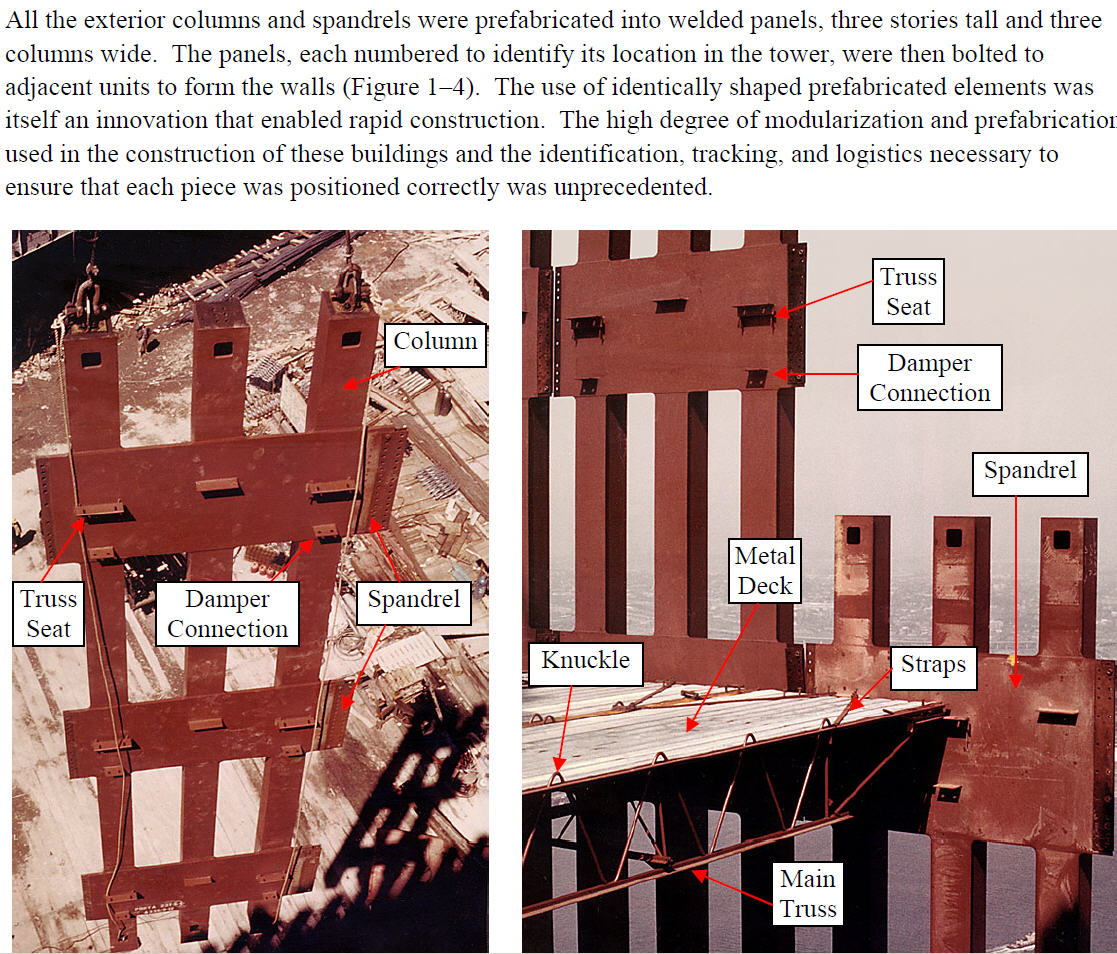
Does the weight of the fuel in the wing not act like the weight of water in a water balloon? When you throw a water balloon, how well does the water balloon hold up on impact?
The wings had fuel in them they were much heaver.
I believe these panels ran something like 7 tons each, not to mention the building they were attached to.

Does the weight of the fuel in the wing not act like the weight of water in a water balloon? When you throw a water balloon, how well does the water balloon hold up on impact?
edit on 6-11-2011 by septic because: (no reason given)
Originally posted by bussoboy
Do you see the woman standing on the edge to the left of of the picture in one of the NIST pictures?
There is a picture showing a close up of the impact zone where a bloke can be seen peering through the window with his hands cupped over his eyes, back the other way from the woman
It looked the same to me, but the guy's head would be about the same size as the woman's torso.
reply to post by waypastvne
I agree, since that was the direction of travel.
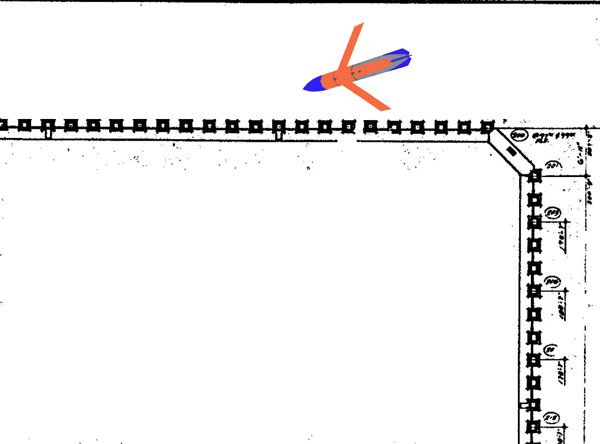
Source
Sideways was the path of least resistance in this case.
I agree, since that was the direction of travel.

Source
Originally posted by septic
Originally posted by waypastvne
I believe these panels ran something like 7 tons each, not to mention the building they were attached to.
Does the weight of the fuel in the wing not act like the weight of water in a water balloon? When you throw a water balloon, how well does the water balloon hold up on impact?
I calculated the volume of steel in a three column panel and got 2.8 tons total. 15 tons of fuel each wing not to mention the plane it was attached to'
Jet fuel is actually lighter than water. Fuel around 6#... water around 8#.... per gal. The wings and fuel only needed to .005 seconds to impart the load. Even a water balloon needs more than that to burst.
Originally posted by septic
reply to post by waypastvne
Sideways was the path of least resistance in this case.
I agree, since that was the direction of travel.
Source
Missiles are not real you proved that using septic logic. You need think of something else.
reply to post by septic
You show the wings as if they broke apart on impact. But most likely they were pulled into the building with the body of the aircraft. This would cause almost a sawing effect as it pulled the wings into the center. Heres a picture of the wings being built. They seem to have more of a angle then what your drawings are showing.
You show the wings as if they broke apart on impact. But most likely they were pulled into the building with the body of the aircraft. This would cause almost a sawing effect as it pulled the wings into the center. Heres a picture of the wings being built. They seem to have more of a angle then what your drawings are showing.
reply to post by septic
The farther away from the fuselage the thinner and less massive the wings are. The wing tips in many cases
are little more than light gauge sheet metal
This is in contrast to the section inboard of the jet engines. Here are large heavy ribs and spars to supprt the
weight of the wing, the fuel tanks and attachments points for the jet engines
These sections had sufficent mass when impacting the columns to shear the bolts and welds connecting the
columns sections together and to push them into the building
The fuel load at impact, some 9600 gal, weigh in at 60,000 lbs. Divided into 2 (30,000 lbs per wing) and given the
speed (500 mph) would act as a solid mass battering its way into the building.
Each jet engine weighs some 6 tons of heavy duty metal
This is in contrast to the outboard section - it had only enough mass to strip away the aluminium outer
cladding and bend the columns - not enought to shear columns away like the more massive inboard sections
The farther away from the fuselage the thinner and less massive the wings are. The wing tips in many cases
are little more than light gauge sheet metal
This is in contrast to the section inboard of the jet engines. Here are large heavy ribs and spars to supprt the
weight of the wing, the fuel tanks and attachments points for the jet engines
These sections had sufficent mass when impacting the columns to shear the bolts and welds connecting the
columns sections together and to push them into the building
The fuel load at impact, some 9600 gal, weigh in at 60,000 lbs. Divided into 2 (30,000 lbs per wing) and given the
speed (500 mph) would act as a solid mass battering its way into the building.
Each jet engine weighs some 6 tons of heavy duty metal
This is in contrast to the outboard section - it had only enough mass to strip away the aluminium outer
cladding and bend the columns - not enought to shear columns away like the more massive inboard sections
Originally posted by waypastvne
I calculated the volume of steel in a three column panel and got 2.8 tons total. 15 tons of fuel each wing not to mention the plane it was attached to'
Jet fuel is actually lighter than water. Fuel around 6#... water around 8#.... per gal. The wings and fuel only needed to .005 seconds to impart the load. Even a water balloon needs more than that to burst.
If any of your claims explained how the wedge shaped wing could damage the towers in a left-right pattern, I might ask for your figures. I figure about 4 plus tons each, but why split hairs.
Source
The damage is visible from many angles, and is consistent with a left-right motion, not a right-left sawing-wedge.

Source
The NIST provides this image of a wing bursting through steel. Does this seem like an accurate explanation of events?

An airplane caused the damage. All evidence points to that. No evidence points elsewhere.
reply to post by septic

Your gift shows exactly what a missile would do if it hit the building. It would rip off it's tiny little fiberglass wing, and the instant it's tiny little fiber glass nose hits the tower, it will bounce back the same direction it came. It's tiny little motor would then push it back forward again, until it hit the building again, this would continue until it ran out of gas. You have proven this to using septic logic.
The same laws have to apply to both missiles and planes.
Sorry Truther those are the rules.

Your gift shows exactly what a missile would do if it hit the building. It would rip off it's tiny little fiberglass wing, and the instant it's tiny little fiber glass nose hits the tower, it will bounce back the same direction it came. It's tiny little motor would then push it back forward again, until it hit the building again, this would continue until it ran out of gas. You have proven this to using septic logic.
The same laws have to apply to both missiles and planes.
Sorry Truther those are the rules.
edit on 6-11-2011 by waypastvne because: (no reason given)
reply to post by waypastvne
I don't know what you mean. I added the link for your benefit, and I thought the animation was a nice touch.
I think a 1000 lb penetrator would have been capable of cutting through two or three columns, especially with a shaped charge going off prior to impact, you know, to pave the way.
This is the same concept behind anti-tank weapons, and you're the first to shout from the rooftops the towers were built with mild steel. How many columns of steel do you think a dozen or so JASSM type missiles could cut with their 1000 lb penetrators at 500 MPH?
Source
If I was a military guy faced with the task of cutting a plane shaped hole in a gigantic steel tourist trap, I'd hit the columns at an angle so as to cut through as many as possible. Looks like one of them was at too shallow of an angle.
As if anyone needed any more convincing NIST is a fraud, this is another example of "jet-inconsistent" damage evidence simply ignored. With all their BS reports based on BS crash videos and pure chutzpah, you'd think they could at least acknowledge the more blatant clues. Their silence speaks volumes.
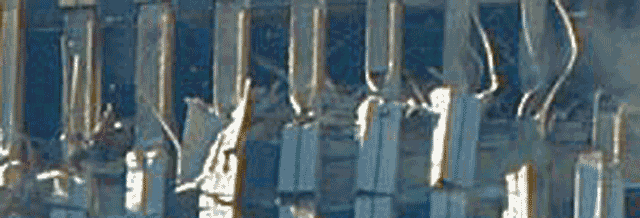
All that would remain would be a compliant media and good old American credulity.
Your gift shows exactly what a missile would do if it hit the building. It would rip off it's tiny little fiberglass wing, and the instant it's tiny little fiber glass nose hits the tower, it will bounce back the same direction it came. It's tiny little motor would then push it back forward again, until it hit the building again, this would continue until it ran out of gas. You have proven this to using septic logic
I don't know what you mean. I added the link for your benefit, and I thought the animation was a nice touch.
I think a 1000 lb penetrator would have been capable of cutting through two or three columns, especially with a shaped charge going off prior to impact, you know, to pave the way.
This is the same concept behind anti-tank weapons, and you're the first to shout from the rooftops the towers were built with mild steel. How many columns of steel do you think a dozen or so JASSM type missiles could cut with their 1000 lb penetrators at 500 MPH?
Source
If I was a military guy faced with the task of cutting a plane shaped hole in a gigantic steel tourist trap, I'd hit the columns at an angle so as to cut through as many as possible. Looks like one of them was at too shallow of an angle.
As if anyone needed any more convincing NIST is a fraud, this is another example of "jet-inconsistent" damage evidence simply ignored. With all their BS reports based on BS crash videos and pure chutzpah, you'd think they could at least acknowledge the more blatant clues. Their silence speaks volumes.

All that would remain would be a compliant media and good old American credulity.
edit on 6-11-2011 by septic because: (no reason given)
reply to post by JBA2848
I think that was the NIST's drawing, but from my understanding the wings of a 767 are swept back about 35 degrees.
The steel striking the wings in a sequential fashion would certainly have shredded a real jet wing, yet the same phenomenon not visible on the opposite side.
In reality, the double-edged, 14" deep, laterally-supported, concrete-floor-backed columns would have struck the much lighter and softer jet at 500 MPH, like a big tomato slicer.
The damage clearly shows a left-right motion, inconsistent with a jet, even if a jet's wings could overcome the laws of nature.
You show the wings as if they broke apart on impact. But most likely they were pulled into the building with the body of the aircraft. This would cause almost a sawing effect as it pulled the wings into the center. Heres a picture of the wings being built. They seem to have more of a angle then what your drawings are showing.
I think that was the NIST's drawing, but from my understanding the wings of a 767 are swept back about 35 degrees.
The steel striking the wings in a sequential fashion would certainly have shredded a real jet wing, yet the same phenomenon not visible on the opposite side.
In reality, the double-edged, 14" deep, laterally-supported, concrete-floor-backed columns would have struck the much lighter and softer jet at 500 MPH, like a big tomato slicer.
The damage clearly shows a left-right motion, inconsistent with a jet, even if a jet's wings could overcome the laws of nature.
Originally posted by DrEugeneFixer
An airplane caused the damage. All evidence points to that. No evidence points elsewhere.
All evidence...snort. As if you've seen all the evidence.
Climb down already.
reply to post by septic
You very clearly laid out the septic logic Impact rules
Speed is not important.
Mass is not important.
The only thing you claimed was important was strength. You said steel is stronger then aluminum.
That shape charge uses copper to cut. Copper is not stronger than steel. Copper is also weaker than aircraft aluminum.
So I'm sorry but you can't use shape charges unless you want to backpedal. And if you do backpedal, then it becomes possible, using septic logic, for a plane to have made that hole.
You also used explosives without explaining to us how they work.Thats a no no. You posted a external source evidence saying shape charges work with mass and speed. This goes against what you told us, You need to explain to us how shape work without contradicting your self..... If you wan't to use them as evidence.
You very clearly laid out the septic logic Impact rules
Speed is not important.
Mass is not important.
The only thing you claimed was important was strength. You said steel is stronger then aluminum.
That shape charge uses copper to cut. Copper is not stronger than steel. Copper is also weaker than aircraft aluminum.
So I'm sorry but you can't use shape charges unless you want to backpedal. And if you do backpedal, then it becomes possible, using septic logic, for a plane to have made that hole.
You also used explosives without explaining to us how they work.Thats a no no. You posted a external source evidence saying shape charges work with mass and speed. This goes against what you told us, You need to explain to us how shape work without contradicting your self..... If you wan't to use them as evidence.
new topics
-
Trudeau Resigns! Breaking
Other Current Events: 8 minutes ago -
Live updates: Congress meets to certify Trump's presidential election victory
US Political Madness: 1 hours ago -
Gravitic Propulsion--What IF the US and China Really Have it?
General Conspiracies: 1 hours ago -
Greatest thing you ever got, or bought?
General Chit Chat: 1 hours ago
top topics
-
Sorry to disappoint you but...
US Political Madness: 16 hours ago, 17 flags -
OK this is sad but very strange stuff
Paranormal Studies: 12 hours ago, 8 flags -
Islam And A Book Of Lies
Religion, Faith, And Theology: 13 hours ago, 6 flags -
Live updates: Congress meets to certify Trump's presidential election victory
US Political Madness: 1 hours ago, 4 flags -
Gravitic Propulsion--What IF the US and China Really Have it?
General Conspiracies: 1 hours ago, 3 flags -
Greatest thing you ever got, or bought?
General Chit Chat: 1 hours ago, 2 flags -
Trudeau Resigns! Breaking
Other Current Events: 8 minutes ago, 2 flags
active topics
-
Paradox of Progress
Ancient & Lost Civilizations • 11 • : crayzeed -
Sorry to disappoint you but...
US Political Madness • 27 • : CriticalStinker -
Trudeau Resigns! Breaking
Other Current Events • 2 • : DerBeobachter2 -
Joe Biden gives the USA's Highest Civilian Honor Award to Hillary Clinton and George Soros.
US Political Madness • 52 • : Coelacanth55 -
ILLUMINATION: Dimensions / Degrees – Da Vincis Last Supper And The Philosophers Stone
Secret Societies • 10 • : CarlLaFong -
Live updates: Congress meets to certify Trump's presidential election victory
US Political Madness • 6 • : Coelacanth55 -
Speaking of Pandemics
General Conspiracies • 8 • : Flyingclaydisk -
Mood Music Part VI
Music • 3779 • : BrucellaOrchitis -
‘Something horrible’: Somerset pit reveals bronze age cannibalism
Ancient & Lost Civilizations • 44 • : BrucellaOrchitis -
Greatest thing you ever got, or bought?
General Chit Chat • 7 • : Flyingclaydisk
